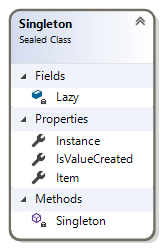Singleton Pattern
Description:
» The Singleton pattern ensures that a class is instantiated only once and that all requests are directed to that one and only object;» The purpose of the Singleton pattern is to ensure that there is only one instance of a class, and that there is a global access point to that object;
» In the Singleton pattern, it is the class itself that is responsible for ensuring this constraint, not the clients of the class.
Use When:
» You need to ensure there is only one instance of a class;» Controlled access to that instance is essential;
» You might need more than one instance at a later stage;
» The control should be localized in the instantiated class, not in some other mechanism.
//Define the Singleton Object
//It's using System.Lazy from .NET 4 (or higher) to make the Singleton Object lazy and thread-safe.
//It's simple and performs well; it also allows you to check whether or not the instance has been created yet with the IsValueCreated property, if you need that.
public sealed class Singleton
{
private Singleton() { }
private static readonly Lazy<Singleton> Lazy = new Lazy<Singleton>(() =>
{
Console.WriteLine("****** Creating Singleton instance ******");
return new Singleton();
});
public static Singleton Instance => Lazy.Value;
public bool IsValueCreated => Lazy.IsValueCreated;
public string Item { get; set; }
}
//It's using System.Lazy
//It's simple and performs well; it also allows you to check whether or not the instance has been created yet with the IsValueCreated property, if you need that.
public sealed class Singleton
{
private Singleton() { }
private static readonly Lazy<Singleton> Lazy = new Lazy<Singleton>(() =>
{
Console.WriteLine("****** Creating Singleton instance ******");
return new Singleton();
});
public static Singleton Instance => Lazy.Value;
public bool IsValueCreated => Lazy.IsValueCreated;
public string Item { get; set; }
}

//Define the Singleton Object
//It's using System.Lazy from .NET 4 (or higher) to make the Singleton Object lazy and thread-safe.
//It's simple and performs well; it also allows you to check whether or not the instance has been created yet with the IsValueCreated property, if you need that.
public sealed class Singleton
{
private Singleton() { }
private static readonly Lazy<Singleton> Lazy = new Lazy<Singleton>(() =>
{
Console.WriteLine("****** Creating Singleton instance ******");
return new Singleton();
});
public static Singleton Instance => Lazy.Value;
public bool IsValueCreated => Lazy.IsValueCreated;
public string Item { get; set; }
}
//It's using System.Lazy
//It's simple and performs well; it also allows you to check whether or not the instance has been created yet with the IsValueCreated property, if you need that.
public sealed class Singleton
{
private Singleton() { }
private static readonly Lazy<Singleton> Lazy = new Lazy<Singleton>(() =>
{
Console.WriteLine("****** Creating Singleton instance ******");
return new Singleton();
});
public static Singleton Instance => Lazy.Value;
public bool IsValueCreated => Lazy.IsValueCreated;
public string Item { get; set; }
}